Bottled Water Market
Bottled Water Market Size and Share Forecast Outlook 2025 to 2035
The bottled water market is projected to grow from USD 330.0 billion in 2025 to USD 470.0 billion by 2035, at a CAGR of 3.6%. Still Water will dominate with a 71.0% market share, while modern trade will lead the distribution channel segment with a 46.0% share.
Bottled Water Market Forecast and Outlook 2025 to 2035
The global bottled water market is projected to reach USD 470 billion by 2035, recording an absolute increase of USD 140 billion over the forecast period. The market is valued at USD 330 billion in 2025 and is set to rise at a CAGR of 3.6% during the assessment period. The overall market size is expected to grow by nearly 1.4 times during the same period, supported by increasing health consciousness among consumers worldwide, driving demand for clean drinking water and rising awareness about hydration benefits globally. However, environmental concerns related to plastic packaging and increasing regulatory restrictions on single-use plastics may pose challenges to market expansion.
Quick Stats for Bottled Water Market
- Bottled Water Market Value (2025): USD 330 billion
- Bottled Water Market Forecast Value (2035): USD 470 billion
- Bottled Water Market Forecast CAGR: 3.6%
- Leading Product Type in Bottled Water Market: Still Water
- Key Growth Regions in Bottled Water Market: North America, Asia Pacific, and Europe
- Top Key Players in Bottled Water Market: Nestlé Waters, Danone, Coca-Cola, PepsiCo, Nongfu Spring, Primo/Culligan, Tingyi, Niagara, Suntory, Bisleri
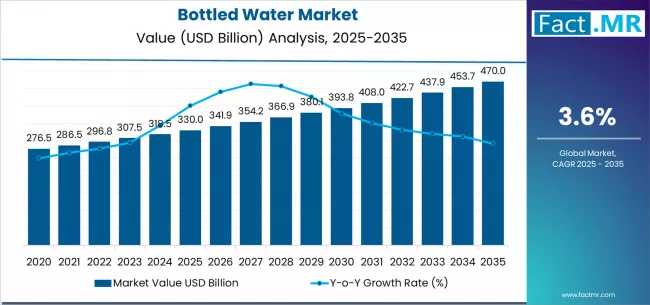
Between 2025 and 2030, the bottled water market is projected to expand from USD 330 billion to USD 395.2 billion, resulting in a value increase of USD 65.2 billion, which represents 46.6% of the total forecast growth for the decade. This phase of development will be shaped by rising health awareness and premium water consumption, product innovation in functional and enhanced water categories, as well as expanding distribution through modern retail channels and e-commerce platforms. Companies are establishing competitive positions through investment in sustainable packaging technologies, premium water sourcing capabilities, and strategic market expansion across developed and emerging markets.
From 2030 to 2035, the market is forecast to grow from USD 395.2 billion to USD 470 billion, adding another USD 74.8 billion, which constitutes 53.4% of the overall ten-year expansion. This period is expected to be characterized by the expansion of specialized functional water products, including mineral-enriched and vitamin-enhanced water varieties tailored for specific consumer segments, strategic partnerships between water companies and health-focused brands, and an enhanced focus on sustainable packaging solutions and environmental responsibility. The growing emphasis on premium hydration experiences and personalized nutrition will drive demand for innovative bottled water solutions across diverse consumer applications.
Bottled Water Market Key Takeaways
| Metric | Value |
|---|---|
| Market Value (2025) | USD 330 billion |
| Market Forecast Value (2035) | USD 470 billion |
| Forecast CAGR (2025-2035) | 3.6% |
Why is the Bottled Water Market Growing?
The bottled water market grows by enabling consumers to access safe, convenient hydration solutions while meeting increasing health and wellness demands without compromising on taste or quality requirements. Health-conscious consumers and active lifestyle enthusiasts face mounting pressure to maintain proper hydration and avoid sugary beverages, with bottled water typically providing 100% natural hydration compared to traditional soft drinks, making clean water consumption essential for health-focused lifestyle positioning. The beverage industry's need for convenient, portable hydration and application-specific water products creates demand for comprehensive bottled water solutions that can provide superior taste, maintain consistent quality, and ensure safe consumption without compromising convenience or health benefits.
Government initiatives promoting healthy beverage consumption and clean water access drive adoption across developed and emerging markets, where safe drinking water has a direct impact on public health and consumer well-being. However, environmental sustainability concerns during plastic waste management and the infrastructure requirements for recycling systems may limit growth among environmentally conscious consumers and regions with strict plastic regulations for single-use packaging systems.
Segmental Analysis
The market is segmented by product type, packaging, and distribution channel. By product type, the market is divided into still water, sparkling water, and functional/enhanced water. Based on packaging, the market is categorized into PET bottles, glass bottles, and cans/others. By distribution channel, the market is divided into modern trade, traditional retail, and online channels. Regionally, the market is divided into Asia Pacific, Europe, North America, and other key regions.
By Product Type, the Still Water Segment Accounts for a Dominant Market Share
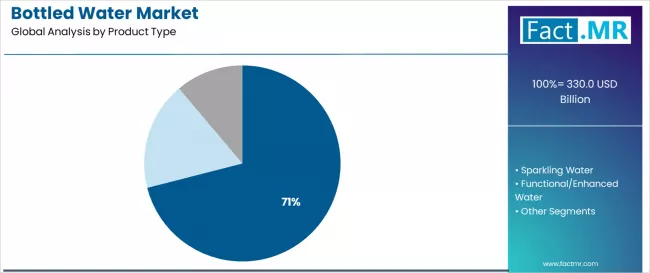
The still water segment represents the dominant force in the bottled water market, capturing approximately 71% of total market share in 2025. This established product category encompasses natural spring water, purified water, and mineral water varieties featuring clean taste profiles and universal consumer appeal across all demographic segments. The still water segment's market leadership stems from its superior versatility and broad consumer acceptance, with products capable of serving hydration needs across diverse consumption occasions while maintaining consistent quality standards and taste preferences across all consumer segments.
The sparkling water segment maintains a substantial 19% market share, serving consumers who prefer carbonated refreshment with enhanced sensory experience for social occasions and premium hydration moments. These products offer refreshing alternatives to soft drinks while providing sophisticated hydration solutions for health-conscious consumers seeking premium beverage experiences. The functional/enhanced water segment accounts for approximately 10% of the market, serving health-focused consumers requiring specialized hydration solutions with added vitamins, minerals, or performance-enhancing ingredients.
Key advantages driving the still water segment include:
- Universal appeal and broad consumer acceptance across all age groups and consumption occasions
- Cost-effective production and distribution enabling competitive pricing strategies
- Versatile applications from basic hydration to premium dining experiences
- Consistent taste profiles that meet diverse regional preferences and quality expectations
By Distribution Channel, the Modern Trade Segment Accounts for the Largest Market Share
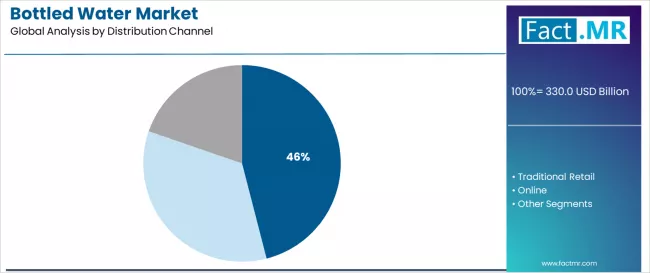
Modern trade channels dominate the bottled water market with approximately 46% market share in 2025, reflecting the critical role of supermarkets, hypermarkets, and convenience stores in supporting global bottled water distribution and consumer accessibility worldwide. The modern trade segment's market leadership is reinforced by convenient shopping experiences, competitive pricing strategies, and extensive product variety that meets diverse consumer preferences across urban and suburban markets.
The traditional retail segment represents the second-largest distribution category, capturing 34.0% market share through local stores, independent retailers, and small-format outlets serving community-based consumption needs. This segment benefits from localized distribution networks that provide accessible hydration solutions in areas with limited modern retail infrastructure, particularly in emerging markets and rural communities.
The online channel segment accounts for 20.0% market share, serving convenience-focused consumers seeking home delivery, bulk purchasing options, and subscription-based hydration solutions. This rapidly growing segment benefits from increasing e-commerce adoption and consumer preference for contactless shopping experiences, particularly post-pandemic consumer behavior changes.
Key market dynamics supporting distribution channel growth include:
- Modern trade expansion driven by urbanization trends and consumer preference for one-stop shopping experiences
- Traditional retail resilience through community relationships and localized service capabilities
- Online channel growth enabled by last-mile delivery improvements and subscription service innovations
- Integrated omnichannel strategies combining physical and digital touchpoints for enhanced consumer convenience
What are the Drivers, Restraints, and Key Trends of the Bottled Water Market?
The market is driven by three concrete demand factors tied to consumer health outcomes. First, increasing health consciousness and wellness trends create rising demand for clean hydration alternatives, with health-focused consumption expanding by 8-12% annually in major developing markets worldwide, requiring comprehensive bottled water infrastructure. Second, urbanization and lifestyle changes drive increased adoption of convenient, portable hydration solutions, with many consumers implementing active lifestyle routines that require reliable access to clean water by 2030. Third, technological advancements in water purification and packaging enable more sustainable and premium products that reduce environmental impact while improving product quality and consumer convenience.
Market restraints include environmental sustainability concerns for plastic packaging that can deter environmentally conscious consumers from regular bottled water consumption, particularly in developed markets where environmental awareness remains high. Regulatory restrictions and plastic bans pose another significant challenge, as governments implement stricter policies on single-use plastics, potentially causing increased production costs and distribution challenges. Economic factors and price sensitivity across different regions create additional operational challenges for premium water providers, demanding ongoing investment in cost-effective production and competitive pricing strategies.
Key trends indicate accelerated adoption in Asia-Pacific markets, particularly China and India, where urbanization and rising disposable incomes drive comprehensive bottled water consumption growth. Technology integration trends toward sustainable packaging solutions with biodegradable materials, smart packaging with tracking capabilities, and premium filtration technologies enable innovative hydration approaches that reduce environmental impact and enhance consumer experience. However, the market thesis could face disruption if alternative hydration methods or significant changes in environmental regulations reduce reliance on traditional bottled water packaging technologies.
Analysis of the Bottled Water Market by Key Country
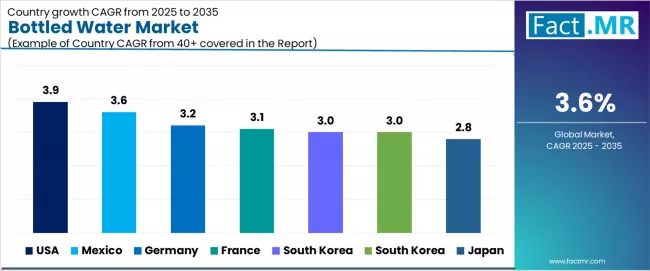
| Country | CAGR (2025-2035) |
|---|---|
| USA | 3.9% |
| Germany | 3.2% |
| France | 3.1% |
| South Korea | 3% |
| UK | 3% |
| Japan | 2.8% |
| Mexico | 3.6% |
The bottled water market is gaining momentum worldwide, with the USA taking the lead thanks to strong health consciousness trends and premium water consumption preferences. Close behind, Germany benefits from expanding wellness culture and sustainable packaging innovations, positioning itself as a strategic growth hub in the European region. France shows steady advancement, where premium mineral water tradition strengthens its role in the European bottled water supply chain. South Korea is focusing on functional water products and health-focused innovations, signaling an ambition to capitalize on the growing opportunities in Asian premium hydration markets. Meanwhile, the UK stands out for its sparkling water adoption and sustainability initiatives, and Japan and Mexico continue to record consistent progress in health-conscious consumption modernization. Together, USA and Germany anchor the global expansion story, while the rest build stability and diversity into the market's growth path.
The report covers an in-depth analysis of 40+ countries top-performing countries are highlighted below.
USA Leads Global Market Expansion
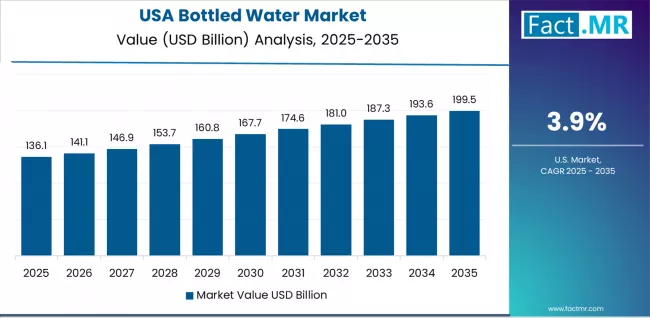
The USA demonstrates the strongest growth potential in the Bottled Water Market with a CAGR of 3.9% through 2035. The country's leadership position stems from strong health consciousness trends, premium water consumption preferences, and extensive retail distribution networks driving the adoption of advanced bottled water solutions. Growth is concentrated in major metropolitan areas, including New York, Los Angeles, Chicago, and Atlanta, where health-focused consumers and active lifestyle enthusiasts are implementing comprehensive hydration strategies for enhanced wellness and convenience. Distribution channels through major retail chains and e-commerce platforms expand coverage across health-conscious consumer segments and premium hydration initiatives. The country's wellness culture and disposable income levels provide market support for premium bottled water adoption, including functional and enhanced water categories.
Key market factors:
- Health consciousness expansion concentrated in urban centers with comprehensive wellness lifestyle development programs
- Retail infrastructure through major chains and convenience stores supporting widespread product availability
- Comprehensive consumer education ecosystem, including health professionals promoting proper hydration practices
- Technology integration featuring premium packaging solutions, sustainable materials, and innovative water enhancement technologies
Germany Emerges as European Leader
In Berlin, Munich, Hamburg, and Frankfurt, the adoption of comprehensive bottled water solutions is accelerating across wellness-focused consumers and sustainability-conscious households, driven by environmental awareness and premium water quality preferences. The market demonstrates strong growth momentum with a CAGR of 3.2% through 2035, linked to comprehensive wellness culture development and increasing focus on sustainable packaging solutions. German consumers are implementing advanced hydration strategies and premium water products to enhance health outcomes while meeting strict environmental standards in expanding wellness and sustainability sectors. The country's environmental regulations and consumer awareness create sustained demand for bottled water solutions, while increasing emphasis on premium quality drives adoption of advanced water purification and sustainable packaging systems.
- Leading wellness-focused cities, including Munich, Berlin, Stuttgart, and Düsseldorf, are driving sustainable hydration adoption
- Environmental consciousness models enabling 25% faster sustainable packaging deployment timelines
- Technology partnership agreements are accelerating development with international premium water providers
- Government policy support through environmental initiatives and wellness promotion programs
France Maintains Premium Tradition
France's premium mineral water sector demonstrates sophisticated implementation of traditional spring water solutions, with documented heritage brands showing consistent quality leadership through natural mineral water sources and premium positioning strategies. The country's beverage culture in major cities, including Paris, Lyon, Marseille, and Nice, showcases integration of premium hydration with culinary traditions, leveraging expertise in mineral water heritage and gastronomic applications. French consumers emphasize quality and authenticity standards, creating demand for premium bottled water solutions that support traditional dining experiences and wellness-focused lifestyle requirements. The market maintains steady growth through focus on premium positioning and heritage brand strength, with a CAGR of 3.1% through 2035.
Key development areas:
- Premium mineral water facilities and heritage spring sources leading quality positioning with comprehensive authenticity programs
- Culinary integration channels providing specialized solutions with fine dining and hospitality applications
- Technology partnerships between French heritage brands and international distribution networks are expanding market reach
- Integration of traditional quality standards with modern sustainability practices and packaging innovations
South Korea Shows Innovation Leadership
South Korea's market expansion is driven by functional water demand, including enhanced hydration products in Seoul and other major cities, and comprehensive wellness technology integration across multiple consumer segments. The country demonstrates promising growth potential with a CAGR of 3.0% through 2035, supported by technology-driven wellness programs and consumer preference for functional beverages. Korean consumers face health optimization challenges related to urban lifestyle demands and wellness technology integration, requiring innovative hydration approaches and support from premium water providers. However, growing wellness awareness and technology adoption create compelling business cases for functional water adoption, particularly in urban areas where convenience and health benefits have a direct impact on lifestyle quality.
Market characteristics:
- Functional water segment showing fastest growth with specialized health-focused product innovation
- Technology integration trends focused on smart packaging and wellness tracking capabilities
- Innovation projections indicate the need for advanced functional ingredients and personalized hydration solutions
- Growing emphasis on convenience and health optimization in urban lifestyle applications
United Kingdom Demonstrates Sustainability Focus
The UK market leads in sustainable bottled water innovation based on integration with environmental responsibility systems and circular economy principles for enhanced packaging sustainability. The country shows moderate growth potential with a CAGR of 3.0% through 2035, driven by the modernization of environmental packaging standards and the expansion of sustainability-focused retail networks in major cities, including London, Manchester, Birmingham, and Glasgow. British consumers are adopting sustainable hydration systems for environmental responsibility and regulatory compliance, particularly in regions with strict environmental requirements and sustainability-focused purchasing decisions demanding comprehensive packaging upgrades. Technology deployment channels through established retail networks and environmental organizations expand coverage across sustainability-conscious consumers and environmental responsibility initiatives.
Leading market segments:
- Sustainable packaging projects in major retail chains are implementing comprehensive environmental responsibility upgrades
- Environmental compliance partnerships with sustainability organizations, achieving significant packaging waste reduction rates
- Strategic collaborations between UK retail companies and sustainable packaging manufacturers are expanding environmental capabilities
- Focus on circular economy principles and environmental responsibility requirements
Japan Emphasizes Quality Excellence
The Bottled Water Market in Japan demonstrates sophisticated implementation focused on quality standards and health optimization, with documented integration of premium water systems, achieving superior purity levels across consumer and institutional applications. The country maintains steady growth momentum with a CAGR of 2.8% through 2035, driven by consumer emphasis on quality standards and health consciousness methodologies that align with wellness culture principles applied to hydration practices. Major metropolitan areas, including Tokyo, Osaka, Nagoya, and Fukuoka, showcase advanced deployment of premium water solutions where quality systems integrate seamlessly with existing wellness infrastructure and comprehensive health management programs.
Key market characteristics:
- Premium water facilities and quality control systems are driving advanced purity requirements with emphasis on health and safety
- Wellness integration partnerships enabling superior quality standards with comprehensive health optimization programs
- Technology collaboration between Japanese quality leaders and international premium water providers is expanding market capabilities
- Emphasis on health optimization requirements and wellness culture integration methodologies
Mexico Shows Regional Growth
Mexico's Bottled Water Market expansion is driven by urbanization trends, including increased access to safe drinking water in Mexico City and other major urban areas, and comprehensive infrastructure development across multiple regions. The country demonstrates strong growth potential with a CAGR of 3.6% through 2035, supported by economic development programs and growing middle-class consumer purchasing power. Mexican consumers face water safety challenges related to infrastructure limitations and quality concerns, requiring reliable bottled water solutions and support from established water companies. However, growing urbanization and disposable income create compelling business cases for bottled water adoption, particularly in urban areas where water quality and convenience have a direct impact on health and lifestyle quality.
Market characteristics:
- Urban expansion segment showing fastest growth with infrastructure development and middle-class growth
- Regional development trends focused on improving water access and quality standards
- Economic projections indicate the need for affordable yet quality hydration solutions and accessible distribution networks
- Growing emphasis on water safety and convenience in developing urban markets
Europe Market Split by Country
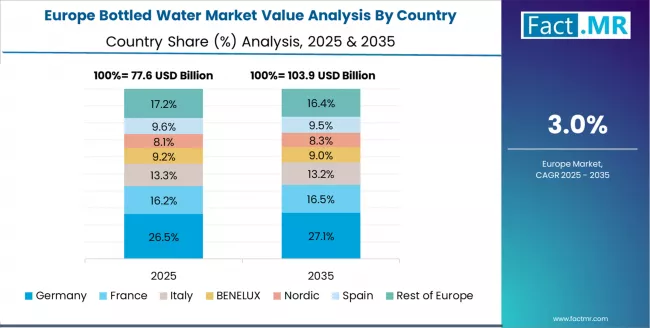
The bottled water market in Europe is projected to grow from USD 82.5 billion in 2025 to USD 117.5 billion by 2035, registering a CAGR of 3.6% over the forecast period. Germany is expected to maintain its leadership position with a 28.5% market share in 2025, increasing slightly to 29.1% by 2035, supported by its strong wellness culture, environmental consciousness, and comprehensive retail distribution networks serving major European markets.
The United Kingdom follows with a 22.3% share in 2025, projected to reach 22.8% by 2035, driven by comprehensive sustainability initiatives in London, Manchester, and other major cities implementing advanced environmental packaging systems. France holds a 21.2% share in 2025, expected to maintain 20.8% by 2035 through the ongoing development of premium mineral water heritage and culinary integration networks. Italy commands a 14.7% share, while Spain accounts for 8.9% in 2025. The Rest of Europe region is anticipated to gain momentum, expanding its collective share from 4.4% to 5.1% by 2035, attributed to increasing bottled water adoption in Nordic countries and emerging Eastern European markets implementing wellness-focused consumption programs.
Still Water Dominates Health-Conscious Demand in Japan
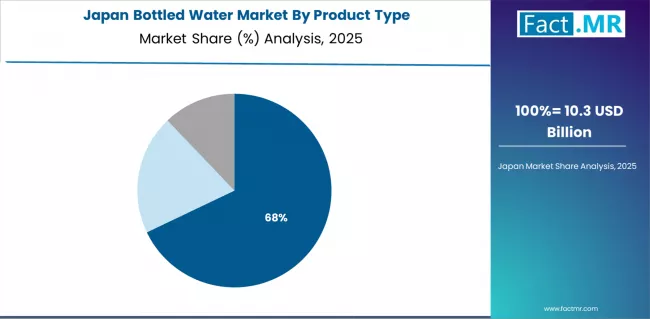
The Japanese Bottled Water Market demonstrates a mature and quality-focused landscape, characterized by sophisticated integration of still water products with existing health consciousness infrastructure across convenience stores, vending machines, and premium retail networks. Japan's emphasis on quality standards and health optimization drives demand for high-purity water solutions that support traditional wellness practices and modern health consciousness initiatives in consumer hydration. The market benefits from strong partnerships between international water providers like Suntory, Coca-Cola, and domestic quality leaders, creating comprehensive service ecosystems that prioritize product purity and consumer health programs. Urban centers in Tokyo, Osaka, Nagoya, and other major metropolitan areas showcase advanced quality implementations where bottled water systems achieve superior purity standards through integrated health monitoring programs.
Technology Providers Lead Premium Water Services in South Korea
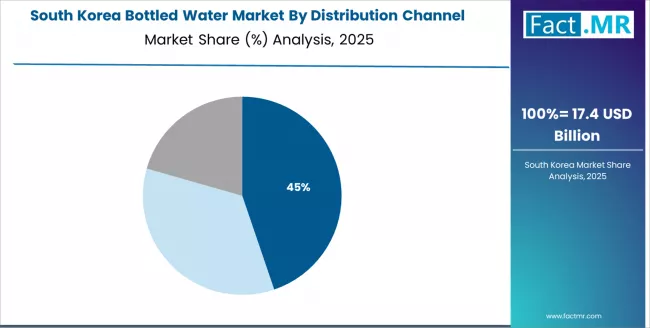
The South Korean Bottled Water Market is characterized by strong international technology provider presence, with companies like Nongfu Spring, Coca-Cola, and PepsiCo maintaining dominant positions through comprehensive distribution integration and innovative product capabilities for functional water and health-focused applications. The market is demonstrating a growing emphasis on functional water products and wellness technology integration, as Korean consumers increasingly demand premium hydration solutions that integrate with domestic wellness culture and advanced health monitoring systems deployed across the Seoul Metropolitan Area and other major technology cities. Local beverage companies and regional distributors are gaining market share through strategic partnerships with global providers, offering specialized products including vitamin-enhanced water and certification services for wellness specialists. The competitive landscape shows increasing collaboration between multinational water companies and Korean wellness specialists, creating hybrid product models that combine international quality expertise with local market knowledge and consumer health management.
Competitive Landscape of the Bottled Water Market
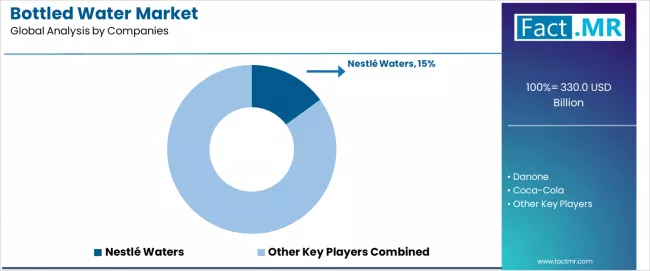
The Bottled Water Market features approximately 60-80 meaningful players with moderate concentration, where the top three companies control roughly 28-35% of global market share through established brand portfolios and extensive distribution networks. Competition centers on brand recognition, product quality, and distribution reach rather than price competition alone.
Market leaders include Nestlé Waters, Danone, and Coca-Cola, which maintain competitive advantages through comprehensive product portfolios, global distribution networks, and deep expertise in the consumer beverage sectors, creating high brand loyalty for customers. These companies leverage established consumer relationships and ongoing marketing investments to defend market positions while expanding into premium and functional water categories.
Challengers encompass PepsiCo and Nongfu Spring, which compete through specialized product innovations and strong regional presence in key consumer markets. Regional specialists, including Primo/Culligan, Tingyi, and Suntory, focus on specific geographic markets or delivery services, offering differentiated capabilities in premium sourcing, local distribution, and consumer-focused solutions.
Local players and emerging bottled water brands create competitive pressure through premium positioning and sustainable packaging innovations, particularly in high-growth markets including Asia and emerging economies, where local presence provides advantages in cultural understanding and regulatory compliance. Market dynamics favor companies that combine strong brand recognition with comprehensive distribution capabilities that address the complete consumer hydration lifecycle from product development through ongoing consumer engagement and loyalty programs.
Key Players in the Bottled Water Market
- Nestlé Waters
- Danone
- Coca-Cola
- PepsiCo
- Nongfu Spring
- Primo/Culligan
- Tingyi
- Niagara
- Suntory
- Bisleri
Scope of the Report
| Item | Value |
|---|---|
| Quantitative Units | USD 330 billion |
| Product Type | Still Water, Sparkling Water, Functional/Enhanced Water |
| Packaging | PET Bottles, Glass Bottles, Cans/Others |
| Distribution Channel | Modern Trade, Traditional Retail, Online |
| Regions Covered | Asia Pacific, Europe, North America, Latin America, Middle East & Africa |
| Country Covered | USA, UK, Germany, France, Japan, South Korea, Mexico, and 40+ countries |
| Key Companies Profiled | Nestlé Waters, Danone, Coca-Cola, PepsiCo, Nongfu Spring, Primo/Culligan, Tingyi, Niagara, Suntory, Bisleri |
| Additional Attributes | Dollar sales by product type and packaging categories, regional consumption trends across Asia Pacific, Europe, and North America, competitive landscape with bottled water manufacturers and distribution partners, consumer preferences and health consciousness factors, integration with wellness trends and lifestyle applications, innovations in sustainable packaging and water enhancement technologies, and development of specialized products with premium positioning and health benefits capabilities. |
Bottled Water Market by Segments
-
Product Type :
- Still Water
- Sparkling Water
- Functional/Enhanced Water
-
Packaging :
- PET Bottles
- Glass Bottles
- Cans/Others
-
Distribution Channel :
- Modern Trade
- Traditional Retail
- Online
-
Region :
- Asia Pacific
- China
- Japan
- South Korea
- India
- Australia & New Zealand
- ASEAN
- Rest of Asia Pacific
- Europe
- Germany
- United Kingdom
- France
- Italy
- Spain
- Nordic
- BENELUX
- Rest of Europe
- North America
- United States
- Canada
- Mexico
- Latin America
- Brazil
- Chile
- Rest of Latin America
- Middle East & Africa
- Kingdom of Saudi Arabia
- Other GCC Countries
- Turkey
- South Africa
- Other African Union
- Rest of Middle East & Africa
- Asia Pacific
Table of Content
- Executive Summary
- Global Market Outlook
- Demand to side Trends
- Supply to side Trends
- Technology Roadmap Analysis
- Analysis and Recommendations
- Market Overview
- Market Coverage / Taxonomy
- Market Definition / Scope / Limitations
- Market Background
- Market Dynamics
- Drivers
- Restraints
- Opportunity
- Trends
- Scenario Forecast
- Demand in Optimistic Scenario
- Demand in Likely Scenario
- Demand in Conservative Scenario
- Opportunity Map Analysis
- Product Life Cycle Analysis
- Supply Chain Analysis
- Investment Feasibility Matrix
- Value Chain Analysis
- PESTLE and Porter’s Analysis
- Regulatory Landscape
- Regional Parent Market Outlook
- Production and Consumption Statistics
- Import and Export Statistics
- Market Dynamics
- Global Market Analysis 2020 to 2024 and Forecast, 2025 to 2035
- Historical Market Size Value (USD Million) Analysis, 2020 to 2024
- Current and Future Market Size Value (USD Million) Projections, 2025 to 2035
- Y to o to Y Growth Trend Analysis
- Absolute $ Opportunity Analysis
- Global Market Pricing Analysis 2020 to 2024 and Forecast 2025 to 2035
- Global Market Analysis 2020 to 2024 and Forecast 2025 to 2035, By Product Type
- Introduction / Key Findings
- Historical Market Size Value (USD Million) Analysis By Product Type , 2020 to 2024
- Current and Future Market Size Value (USD Million) Analysis and Forecast By Product Type , 2025 to 2035
- Still Water
- Sparkling Water
- Functional/Enhanced Water
- Y to o to Y Growth Trend Analysis By Product Type , 2020 to 2024
- Absolute $ Opportunity Analysis By Product Type , 2025 to 2035
- Global Market Analysis 2020 to 2024 and Forecast 2025 to 2035, By Distribution Channel
- Introduction / Key Findings
- Historical Market Size Value (USD Million) Analysis By Distribution Channel, 2020 to 2024
- Current and Future Market Size Value (USD Million) Analysis and Forecast By Distribution Channel, 2025 to 2035
- Modern Trade
- Traditional Retail
- Online
- Y to o to Y Growth Trend Analysis By Distribution Channel, 2020 to 2024
- Absolute $ Opportunity Analysis By Distribution Channel, 2025 to 2035
- Global Market Analysis 2020 to 2024 and Forecast 2025 to 2035, By Region
- Introduction
- Historical Market Size Value (USD Million) Analysis By Region, 2020 to 2024
- Current Market Size Value (USD Million) Analysis and Forecast By Region, 2025 to 2035
- North America
- Latin America
- Western Europe
- Eastern Europe
- East Asia
- South Asia and Pacific
- Middle East & Africa
- Market Attractiveness Analysis By Region
- North America Market Analysis 2020 to 2024 and Forecast 2025 to 2035, By Country
- Historical Market Size Value (USD Million) Trend Analysis By Market Taxonomy, 2020 to 2024
- Market Size Value (USD Million) Forecast By Market Taxonomy, 2025 to 2035
- By Country
- USA
- Canada
- Mexico
- By Product Type
- By Distribution Channel
- By Country
- Market Attractiveness Analysis
- By Country
- By Product Type
- By Distribution Channel
- Key Takeaways
- Latin America Market Analysis 2020 to 2024 and Forecast 2025 to 2035, By Country
- Historical Market Size Value (USD Million) Trend Analysis By Market Taxonomy, 2020 to 2024
- Market Size Value (USD Million) Forecast By Market Taxonomy, 2025 to 2035
- By Country
- Brazil
- Chile
- Rest of Latin America
- By Product Type
- By Distribution Channel
- By Country
- Market Attractiveness Analysis
- By Country
- By Product Type
- By Distribution Channel
- Key Takeaways
- Western Europe Market Analysis 2020 to 2024 and Forecast 2025 to 2035, By Country
- Historical Market Size Value (USD Million) Trend Analysis By Market Taxonomy, 2020 to 2024
- Market Size Value (USD Million) Forecast By Market Taxonomy, 2025 to 2035
- By Country
- Germany
- UK
- Italy
- Spain
- France
- Nordic
- BENELUX
- Rest of Western Europe
- By Product Type
- By Distribution Channel
- By Country
- Market Attractiveness Analysis
- By Country
- By Product Type
- By Distribution Channel
- Key Takeaways
- Eastern Europe Market Analysis 2020 to 2024 and Forecast 2025 to 2035, By Country
- Historical Market Size Value (USD Million) Trend Analysis By Market Taxonomy, 2020 to 2024
- Market Size Value (USD Million) Forecast By Market Taxonomy, 2025 to 2035
- By Country
- Russia
- Poland
- Hungary
- Balkan & Baltic
- Rest of Eastern Europe
- By Product Type
- By Distribution Channel
- By Country
- Market Attractiveness Analysis
- By Country
- By Product Type
- By Distribution Channel
- Key Takeaways
- East Asia Market Analysis 2020 to 2024 and Forecast 2025 to 2035, By Country
- Historical Market Size Value (USD Million) Trend Analysis By Market Taxonomy, 2020 to 2024
- Market Size Value (USD Million) Forecast By Market Taxonomy, 2025 to 2035
- By Country
- China
- Japan
- South Korea
- By Product Type
- By Distribution Channel
- By Country
- Market Attractiveness Analysis
- By Country
- By Product Type
- By Distribution Channel
- Key Takeaways
- South Asia and Pacific Market Analysis 2020 to 2024 and Forecast 2025 to 2035, By Country
- Historical Market Size Value (USD Million) Trend Analysis By Market Taxonomy, 2020 to 2024
- Market Size Value (USD Million) Forecast By Market Taxonomy, 2025 to 2035
- By Country
- India
- ASEAN
- Australia & New Zealand
- Rest of South Asia and Pacific
- By Product Type
- By Distribution Channel
- By Country
- Market Attractiveness Analysis
- By Country
- By Product Type
- By Distribution Channel
- Key Takeaways
- Middle East & Africa Market Analysis 2020 to 2024 and Forecast 2025 to 2035, By Country
- Historical Market Size Value (USD Million) Trend Analysis By Market Taxonomy, 2020 to 2024
- Market Size Value (USD Million) Forecast By Market Taxonomy, 2025 to 2035
- By Country
- Kingdom of Saudi Arabia
- Other GCC Countries
- Turkiye
- South Africa
- Other African Union
- Rest of Middle East & Africa
- By Product Type
- By Distribution Channel
- By Country
- Market Attractiveness Analysis
- By Country
- By Product Type
- By Distribution Channel
- Key Takeaways
- Key Countries Market Analysis
- USA
- Pricing Analysis
- Market Share Analysis, 2024
- By Product Type
- By Distribution Channel
- Canada
- Pricing Analysis
- Market Share Analysis, 2024
- By Product Type
- By Distribution Channel
- Mexico
- Pricing Analysis
- Market Share Analysis, 2024
- By Product Type
- By Distribution Channel
- Brazil
- Pricing Analysis
- Market Share Analysis, 2024
- By Product Type
- By Distribution Channel
- Chile
- Pricing Analysis
- Market Share Analysis, 2024
- By Product Type
- By Distribution Channel
- Germany
- Pricing Analysis
- Market Share Analysis, 2024
- By Product Type
- By Distribution Channel
- UK
- Pricing Analysis
- Market Share Analysis, 2024
- By Product Type
- By Distribution Channel
- Italy
- Pricing Analysis
- Market Share Analysis, 2024
- By Product Type
- By Distribution Channel
- Spain
- Pricing Analysis
- Market Share Analysis, 2024
- By Product Type
- By Distribution Channel
- France
- Pricing Analysis
- Market Share Analysis, 2024
- By Product Type
- By Distribution Channel
- India
- Pricing Analysis
- Market Share Analysis, 2024
- By Product Type
- By Distribution Channel
- ASEAN
- Pricing Analysis
- Market Share Analysis, 2024
- By Product Type
- By Distribution Channel
- Australia & New Zealand
- Pricing Analysis
- Market Share Analysis, 2024
- By Product Type
- By Distribution Channel
- China
- Pricing Analysis
- Market Share Analysis, 2024
- By Product Type
- By Distribution Channel
- Japan
- Pricing Analysis
- Market Share Analysis, 2024
- By Product Type
- By Distribution Channel
- South Korea
- Pricing Analysis
- Market Share Analysis, 2024
- By Product Type
- By Distribution Channel
- Russia
- Pricing Analysis
- Market Share Analysis, 2024
- By Product Type
- By Distribution Channel
- Poland
- Pricing Analysis
- Market Share Analysis, 2024
- By Product Type
- By Distribution Channel
- Hungary
- Pricing Analysis
- Market Share Analysis, 2024
- By Product Type
- By Distribution Channel
- Kingdom of Saudi Arabia
- Pricing Analysis
- Market Share Analysis, 2024
- By Product Type
- By Distribution Channel
- Turkiye
- Pricing Analysis
- Market Share Analysis, 2024
- By Product Type
- By Distribution Channel
- South Africa
- Pricing Analysis
- Market Share Analysis, 2024
- By Product Type
- By Distribution Channel
- USA
- Market Structure Analysis
- Competition Dashboard
- Competition Benchmarking
- Market Share Analysis of Top Players
- By Regional
- By Product Type
- By Distribution Channel
- Competition Analysis
- Competition Deep Dive
- Nestlé Waters
- Overview
- Product Portfolio
- Profitability by Market Segments (Product/Age /Sales Channel/Region)
- Sales Footprint
- Strategy Overview
- Marketing Strategy
- Product Strategy
- Channel Strategy
- Danone
- Coca-Cola
- PepsiCo
- Nongfu Spring
- Primo/Culligan
- Tingyi
- Niagara
- Suntory
- Bisleri
- Nestlé Waters
- Competition Deep Dive
- Assumptions & Acronyms Used
- Research Methodology
List Of Table
- Table 1: Global Market Value (USD Million) Forecast by Region, 2020 to 2035
- Table 2: Global Market Value (USD Million) Forecast by Product Type , 2020 to 2035
- Table 3: Global Market Value (USD Million) Forecast by Distribution Channel, 2020 to 2035
- Table 4: North America Market Value (USD Million) Forecast by Country, 2020 to 2035
- Table 5: North America Market Value (USD Million) Forecast by Product Type , 2020 to 2035
- Table 6: North America Market Value (USD Million) Forecast by Distribution Channel, 2020 to 2035
- Table 7: Latin America Market Value (USD Million) Forecast by Country, 2020 to 2035
- Table 8: Latin America Market Value (USD Million) Forecast by Product Type , 2020 to 2035
- Table 9: Latin America Market Value (USD Million) Forecast by Distribution Channel, 2020 to 2035
- Table 10: Western Europe Market Value (USD Million) Forecast by Country, 2020 to 2035
- Table 11: Western Europe Market Value (USD Million) Forecast by Product Type , 2020 to 2035
- Table 12: Western Europe Market Value (USD Million) Forecast by Distribution Channel, 2020 to 2035
- Table 13: Eastern Europe Market Value (USD Million) Forecast by Country, 2020 to 2035
- Table 14: Eastern Europe Market Value (USD Million) Forecast by Product Type , 2020 to 2035
- Table 15: Eastern Europe Market Value (USD Million) Forecast by Distribution Channel, 2020 to 2035
- Table 16: East Asia Market Value (USD Million) Forecast by Country, 2020 to 2035
- Table 17: East Asia Market Value (USD Million) Forecast by Product Type , 2020 to 2035
- Table 18: East Asia Market Value (USD Million) Forecast by Distribution Channel, 2020 to 2035
- Table 19: South Asia and Pacific Market Value (USD Million) Forecast by Country, 2020 to 2035
- Table 20: South Asia and Pacific Market Value (USD Million) Forecast by Product Type , 2020 to 2035
- Table 21: South Asia and Pacific Market Value (USD Million) Forecast by Distribution Channel, 2020 to 2035
- Table 22: Middle East & Africa Market Value (USD Million) Forecast by Country, 2020 to 2035
- Table 23: Middle East & Africa Market Value (USD Million) Forecast by Product Type , 2020 to 2035
- Table 24: Middle East & Africa Market Value (USD Million) Forecast by Distribution Channel, 2020 to 2035
List Of Figures
- Figure 1: Global Market Pricing Analysis
- Figure 2: Global Market Value (USD Million) Forecast 2020-2035
- Figure 3: Global Market Value Share and BPS Analysis by Product Type , 2025 and 2035
- Figure 4: Global Market Y to o to Y Growth Comparison by Product Type , 2025-2035
- Figure 5: Global Market Attractiveness Analysis by Product Type
- Figure 6: Global Market Value Share and BPS Analysis by Distribution Channel, 2025 and 2035
- Figure 7: Global Market Y to o to Y Growth Comparison by Distribution Channel, 2025-2035
- Figure 8: Global Market Attractiveness Analysis by Distribution Channel
- Figure 9: Global Market Value (USD Million) Share and BPS Analysis by Region, 2025 and 2035
- Figure 10: Global Market Y to o to Y Growth Comparison by Region, 2025-2035
- Figure 11: Global Market Attractiveness Analysis by Region
- Figure 12: North America Market Incremental Dollar Opportunity, 2025-2035
- Figure 13: Latin America Market Incremental Dollar Opportunity, 2025-2035
- Figure 14: Western Europe Market Incremental Dollar Opportunity, 2025-2035
- Figure 15: Eastern Europe Market Incremental Dollar Opportunity, 2025-2035
- Figure 16: East Asia Market Incremental Dollar Opportunity, 2025-2035
- Figure 17: South Asia and Pacific Market Incremental Dollar Opportunity, 2025-2035
- Figure 18: Middle East & Africa Market Incremental Dollar Opportunity, 2025-2035
- Figure 19: North America Market Value Share and BPS Analysis by Country, 2025 and 2035
- Figure 20: North America Market Value Share and BPS Analysis by Product Type , 2025 and 2035
- Figure 21: North America Market Y to o to Y Growth Comparison by Product Type , 2025-2035
- Figure 22: North America Market Attractiveness Analysis by Product Type
- Figure 23: North America Market Value Share and BPS Analysis by Distribution Channel, 2025 and 2035
- Figure 24: North America Market Y to o to Y Growth Comparison by Distribution Channel, 2025-2035
- Figure 25: North America Market Attractiveness Analysis by Distribution Channel
- Figure 26: Latin America Market Value Share and BPS Analysis by Country, 2025 and 2035
- Figure 27: Latin America Market Value Share and BPS Analysis by Product Type , 2025 and 2035
- Figure 28: Latin America Market Y to o to Y Growth Comparison by Product Type , 2025-2035
- Figure 29: Latin America Market Attractiveness Analysis by Product Type
- Figure 30: Latin America Market Value Share and BPS Analysis by Distribution Channel, 2025 and 2035
- Figure 31: Latin America Market Y to o to Y Growth Comparison by Distribution Channel, 2025-2035
- Figure 32: Latin America Market Attractiveness Analysis by Distribution Channel
- Figure 33: Western Europe Market Value Share and BPS Analysis by Country, 2025 and 2035
- Figure 34: Western Europe Market Value Share and BPS Analysis by Product Type , 2025 and 2035
- Figure 35: Western Europe Market Y to o to Y Growth Comparison by Product Type , 2025-2035
- Figure 36: Western Europe Market Attractiveness Analysis by Product Type
- Figure 37: Western Europe Market Value Share and BPS Analysis by Distribution Channel, 2025 and 2035
- Figure 38: Western Europe Market Y to o to Y Growth Comparison by Distribution Channel, 2025-2035
- Figure 39: Western Europe Market Attractiveness Analysis by Distribution Channel
- Figure 40: Eastern Europe Market Value Share and BPS Analysis by Country, 2025 and 2035
- Figure 41: Eastern Europe Market Value Share and BPS Analysis by Product Type , 2025 and 2035
- Figure 42: Eastern Europe Market Y to o to Y Growth Comparison by Product Type , 2025-2035
- Figure 43: Eastern Europe Market Attractiveness Analysis by Product Type
- Figure 44: Eastern Europe Market Value Share and BPS Analysis by Distribution Channel, 2025 and 2035
- Figure 45: Eastern Europe Market Y to o to Y Growth Comparison by Distribution Channel, 2025-2035
- Figure 46: Eastern Europe Market Attractiveness Analysis by Distribution Channel
- Figure 47: East Asia Market Value Share and BPS Analysis by Country, 2025 and 2035
- Figure 48: East Asia Market Value Share and BPS Analysis by Product Type , 2025 and 2035
- Figure 49: East Asia Market Y to o to Y Growth Comparison by Product Type , 2025-2035
- Figure 50: East Asia Market Attractiveness Analysis by Product Type
- Figure 51: East Asia Market Value Share and BPS Analysis by Distribution Channel, 2025 and 2035
- Figure 52: East Asia Market Y to o to Y Growth Comparison by Distribution Channel, 2025-2035
- Figure 53: East Asia Market Attractiveness Analysis by Distribution Channel
- Figure 54: South Asia and Pacific Market Value Share and BPS Analysis by Country, 2025 and 2035
- Figure 55: South Asia and Pacific Market Value Share and BPS Analysis by Product Type , 2025 and 2035
- Figure 56: South Asia and Pacific Market Y to o to Y Growth Comparison by Product Type , 2025-2035
- Figure 57: South Asia and Pacific Market Attractiveness Analysis by Product Type
- Figure 58: South Asia and Pacific Market Value Share and BPS Analysis by Distribution Channel, 2025 and 2035
- Figure 59: South Asia and Pacific Market Y to o to Y Growth Comparison by Distribution Channel, 2025-2035
- Figure 60: South Asia and Pacific Market Attractiveness Analysis by Distribution Channel
- Figure 61: Middle East & Africa Market Value Share and BPS Analysis by Country, 2025 and 2035
- Figure 62: Middle East & Africa Market Value Share and BPS Analysis by Product Type , 2025 and 2035
- Figure 63: Middle East & Africa Market Y to o to Y Growth Comparison by Product Type , 2025-2035
- Figure 64: Middle East & Africa Market Attractiveness Analysis by Product Type
- Figure 65: Middle East & Africa Market Value Share and BPS Analysis by Distribution Channel, 2025 and 2035
- Figure 66: Middle East & Africa Market Y to o to Y Growth Comparison by Distribution Channel, 2025-2035
- Figure 67: Middle East & Africa Market Attractiveness Analysis by Distribution Channel
- Figure 68: Global Market - Tier Structure Analysis
- Figure 69: Global Market - Company Share Analysis
- FAQs -
How big is the bottled water market in 2025?
The global bottled water market is estimated to be valued at USD 330.0 billion in 2025.
What will be the size of bottled water market in 2035?
The market size for the bottled water market is projected to reach USD 470.0 billion by 2035.
How much will be the bottled water market growth between 2025 and 2035?
The bottled water market is expected to grow at a 3.6% CAGR between 2025 and 2035.
What are the key product types in the bottled water market?
The key product types in bottled water market are still water, sparkling water and functional/enhanced water.
Which distribution channel segment to contribute significant share in the bottled water market in 2025?
In terms of distribution channel, modern trade segment to command 46.0% share in the bottled water market in 2025.